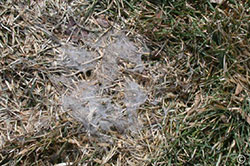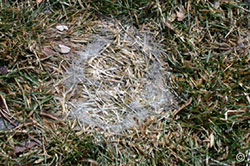What is snow mold?
Gray snow mold, caused by the fungus Typhula incarnate can occur on many Front Range lawns. Snow mold occurs during periods of prolonged snow cover, but can also occur where leaves and other debris have accumulated on lawns during the fall and winter. North-facing lawns, shaded lawns and areas where snowplowing or drifting snow created especially deep snow are most commonly affected.
What does snow mold look like?
The fungus is active in moist lawns at temperatures just above freezing. Circular patches (6-12 inches) will have a moldy appearance when fungus is actively growing – usually just as the snow melts. Under severe conditions, these smaller patches may grow together to form large, matted areas that appear to be dead. As the lawn begins to dry out the fungal growth slows. Patches can take on a light tan appearance, fading to light gray or white.
Will this kill my grass?

This disease rarely kills bluegrass lawns, although young seedlings from a late fall seeding may be killed (sod laid the in the fall should be okay).
Will fungicide control snow mold?
Fungicide applications are not recommended when snow mold occurs in a lawn. Spring fungicide applications will NOT effectively control or prevent the disease, nor will fungicide use hasten spring turf recovery.
How can I recover my grass?
 The best way to speed recovery is to remove dead and matted material by lightly raking to promote air circulation and drying. Light spring nitrogen fertilization (especially if no fertilizer was applied the previous fall) will help speed the growth of new grass from the underground stems that are not harmed by the snow mold fungus. Lawns that appear slow to recover in the spring will benefit from core aeration, followed by over seeding with the same grass species already present in the lawn.
The best way to speed recovery is to remove dead and matted material by lightly raking to promote air circulation and drying. Light spring nitrogen fertilization (especially if no fertilizer was applied the previous fall) will help speed the growth of new grass from the underground stems that are not harmed by the snow mold fungus. Lawns that appear slow to recover in the spring will benefit from core aeration, followed by over seeding with the same grass species already present in the lawn.
Does fertilizer play a role in snow mold?
Contrary to popular belief, late-season fertilization (also referred to as “fall” or “winterizer” fertilization) neither encourages snow mold nor increases its severity. In fact, late-season/fall fertilization will encourage more rapid healing and recovery in lawns afflicted with snow mold.



